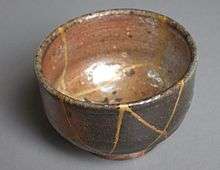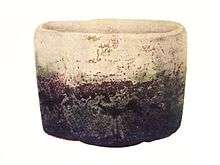Kintsugi

Kintsugi (金継ぎ?, きんつぎ, "golden joinery") , also known as Kintsukuroi (金繕い?, きんつくろい, "golden repair") ,[1] is the Japanese art of repairing broken pottery with lacquer dusted or mixed with powdered gold, silver, or platinum, a method similar to the maki-e technique.[2][3][4] As a philosophy, it treats breakage and repair as part of the history of an object, rather than something to disguise.
Origin
Lacquerware is a longstanding tradition in Japan,[5][6] at some point it may have been combined with maki-e as a replacement for other ceramic repair techniques. One theory is that kintsugi may have originated when Japanese shogun Ashikaga Yoshimasa sent a damaged Chinese tea bowl back to China for repairs in the late 15th century.[7] When it was returned, repaired with ugly metal staples, it may have prompted Japanese craftsmen to look for a more aesthetic means of repair. Collectors became so enamored with the new art that some were accused of deliberately smashing valuable pottery so it could be repaired with the gold seams of kintsugi.[2] Kintsugi became closely associated with ceramic vessels used for chanoyu (Japanese tea ceremony).[3] While the process is associated with Japanese craftsmen, the technique was applied to ceramic pieces of other origins including China, Vietnam, and Korea.[8]
Philosophy
As a philosophy, kintsugi can be seen to have similarities to the Japanese philosophy of wabi-sabi, an embracing of the flawed or imperfect.[9] Japanese aesthetics values marks of wear by the use of an object. This can be seen as a rationale for keeping an object around even after it has broken and as a justification of kintsugi itself, highlighting the cracks and repairs as simply an event in the life of an object rather than allowing its service to end at the time of its damage or breakage.[10]
Kintsugi can relate to the Japanese philosophy of "no mind" (無心 mushin), which encompasses the concepts of non-attachment, acceptance of change and fate as aspects of human life.[11]
| “ | Not only is there no attempt to hide the damage, but the repair is literally illuminated... a kind of physical expression of the spirit of mushin....Mushin is often literally translated as “no mind,” but carries connotations of fully existing within the moment, of non-attachment, of equanimity amid changing conditions. ...The vicissitudes of existence over time, to which all humans are susceptible, could not be clearer than in the breaks, the knocks, and the shattering to which ceramic ware too is subject. This poignancy or aesthetic of existence has been known in Japan as mono no aware, a compassionate sensitivity, or perhaps identification with, [things] outside oneself. | ” | |
| — Christy Bartlett, Flickwerk: The Aesthetics of Mended Japanese Ceramics | |||
Types of joinery
There are a few major styles or types of kintsugi:
- Crack (ひび), the use of gold dust and resin or lacquer to attach broken pieces with minimal overlap or fill-in from missing pieces
- Piece Method (欠けの金継ぎ例), where a replacement ceramic fragment is not available and the entirety of the addition is gold or gold/lacquer compound
- Joint Call (呼び継ぎ), where a similarly shaped but non-matching fragment is used to replace a missing piece from the original vessel creating a patchwork effect.[12]
Related techniques

Staple repair is a similar technique used to repair broken ceramic pieces,[13] where small holes are drilled on either side of a crack and metal staples are bent to hold the pieces together.[14] Staple repair was used in Europe (in Ancient Greece, England and Russia among others) and China as a repair technique for particularly valuable pieces.[14]
Influence on modern art
Kintsugi is the general concept of highlighting or emphasizing imperfections, visualizing mends and seams as additive or an area to celebrate or focus on rather than as absence or missing pieces. Modern artists experiment with the ancient technique as a means of analyzing the idea of loss, synthesis, and improvement through destruction and repair or rebirth.[15]
While originally ignored as a separate art form, kintsugi and related repair methods have been featured at exhibitions at the Freer Gallery at the Smithsonian and the Metropolitan Museum of Art.[2][8][9]
The concept of Kintsugi inspired Tim Baker of the Canadian band Hey Rosetta! in the making of their 2014 album, Second Sight. The lead single, "Kintsukuroi," takes its name directly from the artform and the cover art of the record features a bowl repaired in the kintsugi method.
Canadian folk band The Rural Alberta Advantage also used kintsugi as inspiration for the art for their tellingly named 2014 record, Mended with Gold.
Death Cab for Cutie also named their 2015 release Kintsugi, possibly because during the production of the album, lead guitarist and founding member Chris Walla announced that he was leaving the band (though he continued contributing to the recording and creative process as a full member until the album's completion).[16]
See also
References
- ↑ "definition of Kinstugi".
- 1 2 3 Gopnik, Blake (March 3, 2009), "At Freer, Aesthetic Is Simply Smashing", The Washington Post.
- 1 2 "Golden Seams: The Japanese Art of Mending Ceramics", Freer Gallery of Art, Smithsonian, retrieved 3 March 2009.
- ↑ "Daijisen".
- ↑ Ota, Alan K. (September 22, 1985). "Japan's Ancient Art of Lacquerware". New York Times. New York Times.
- ↑ Johnson; Ken (April 4, 2008). "A Craft Polished to the Lofty Heights of Art". New York Times. New York Times. Retrieved April 5, 2014.
- ↑ Gopnik, Blake (March 3, 2009). "'Golden Seams: The Japanese Art of Mending Ceramics' at Freer". The Washington Post.
- 1 2 "Golden Seams: The Japanese Art of Mending Ceramics". Smithsonian. November 8, 2008. Retrieved 2014-04-05.
- 1 2 Andrea Codrington, Lippke (December 15, 2010). "In Make-Do Objects, Collectors Find Beauty Beyond Repair". New York Times. Retrieved 2014-04-05.
- ↑ Kwan, Pui Ying. "Exploring Japanese Art and Aesthetic as inspiration for emotionally durable design" (PDF).
- ↑ Flickwerk The Aesthetics of Mended Japanese Ceramics Paperback, January 1, 2008 by Christy, James Henry Holland and Charly Iten Bartlett
- ↑ "Gold joint (mending gold) What is it?" (in Japanese). 2013-05-04. Retrieved 2014-04-02.
- ↑ Kahn, Eve (January 17, 2013). "It's as Good as Glue: Mending Shattered China". New York Times. Retrieved 2014-04-05.
- 1 2 "Stapled Repairs on Chine; Confessions of a curious collector". Antiques Journal. February 2012: 37–40. Retrieved 2014-04-05.
- ↑ Taylor, Andrew (February 27, 2011). "Smashing idea to put it together again". Sydney Morning Herald.
- ↑ Courneen, Trevor (January 12, 2015). "Death Cab for Cutie Reveal Title and Track List for New Album". Paste Magazine. Retrieved 2015-01-13.
Further reading
- Flickwerk The Aesthetics of Mended Japanese Ceramics — Christy, James; Holland, Henry; Bartlett, Charly Iten (2008). Flickwerk The Aesthetics of Mended Japanese Ceramics. Cornell University, Herbert Johnson Museum of Art. ASIN B009F3YENM.
- Kintsugi: The Meaning of Mending by Adam Fulford (Video on Vimeo)
- EASTERN PHILOSOPHY - Kintsugi by School of Life (Video on Youtube)
External links
![]() Media related to Kintsugi at Wikimedia Commons
Media related to Kintsugi at Wikimedia Commons
- https://www.pinterest.com/pin/376895062538454047/
- Exhibition FLICKWERK The Aesthetics of Mended Japanese Ceramics at Herbert F. Johnson Museum of Art, Ithaca NY 2008
